- Acne
- Actinic Keratosis
- Aesthetics
- Alopecia
- Atopic Dermatitis
- Buy-and-Bill
- COVID-19
- Case-Based Roundtable
- Chronic Hand Eczema
- Drug Watch
- Eczema
- General Dermatology
- Hidradenitis Suppurativa
- Melasma
- NP and PA
- Pediatric Dermatology
- Pigmentary Disorders
- Practice Management
- Precision Medicine and Biologics
- Prurigo Nodularis
- Psoriasis
- Psoriatic Arthritis
- Rare Disease
- Rosacea
- Skin Cancer
- Vitiligo
- Wound Care
News
Article
Dermatology Times
Journal Digest: October 10
Author(s):
This week’s collection of the latest dermatologic studies covers the incidence of keratinocyte carcinomas, upadacitinib used to treat discoid lupus erythematosus, considerations about hair camouflage for Black women with alopecia, and parent perspectives of infants undergoing surgical treatment for congenital melanocytic nevus.

European Journal of Dermatology: Incidence of Keratinocyte Carcinomas in Italy: An Exercise in Indirect Estimation Based on Melanoma Data
A recent study by Samela et al aimed to assess the incidence of keratinocyte carcinomas and their relationship with melanoma, revealing the underreporting of these tumors. The study gathered data from Italian dermatologists through snowball sampling, excluding those from melanoma units. Results showed that the BCC/melanoma ratio was 4.4 and SCC/melanoma ratio was 1.7, significantly lower than dermatologists' self-reported ratios. However, the BCC/SCC ratio remained consistent at 2.8, closer to the histopathological data's ratio of 2.6. This suggests that in Italy, the actual occurrence of BCC and SCC is underestimated compared to dermatologists' reports, highlighting the need for more accurate data collection.
Clinical, Cosmetic and Investigational Dermatology: Treatment of Discoid Lupus Erythematous With Upadacitinib: A Case Report
Hu and Lian’s study discusses the treatment of cutaneous lupus erythematosus (CLE), which encompasses various types based on clinical, histopathological, and serological features. Discoid lupus erythematosus (DLE), a subtype of CLE, is characterized by erythematous plaques with adherent scales and often leads to misdiagnosis when it mimics other conditions. Treatment options for CLE include corticosteroids and antimalarials, but long-term use of these drugs can have adverse effects. This study presents a case of DLE successfully treated with upadacitinib after other treatments failed. Upadacitinib was well-tolerated over the 28-week treatment. The authors noted that consistent dosage is crucial to avoid a relapse in skin lesions. While promising, more research is needed to establish the safety and efficacy of upadacitinib for CLE.
International Journal of Women’s Dermatology: Considerations and Recommendations on Camouflage in Alopecia in Black Women
Taye et al explore the practice of hair camouflage, particularly in Black communities, where hair is a significant aspect of identity and self-expression. According to the study, today, about 50% of Black women use some form of hair camouflage, with motivations including cultural expression, hair protection, and professional conformity. Popular hair camouflage techniques include wigs, extensions, and topical hair fibers, with varying advantages and disadvantages. The study authors mention the potential exacerbation of alopecia due to adhesives, chemicals, and high-tension braiding, and caution their use. Taye et al report that “Black Americans are the only ethnic group in which alopecia is among the top 10 dermatologic conditions,” making it crucial for dermatology clinicians to provide thoughtful counseling regarding hair camouflage techniques for patients with alopecia.
Journal of Cutaneous Medicine and Surgery: Surgical Therapy of Congenital Nevi in the First Year of Life – Psychological Impact on Parents
Schwenk et al examined the perspective of parents of infants with congenital melanocytic nevi who underwent surgical treatment. The study aimed to understand parents' psychological burden, motivations for surgery, and satisfaction with the outcomes. Among the key findings, 62.2% of parents experienced severe distress at the time of their child's birth, which decreased over time with information and treatment progress. Stigmatization was reported by 35.6% of parents. However, 84.5% were highly satisfied with early surgical therapy, with concerns about malignancy and stigmatization motivating surgery. The study highlights the importance of early education and surgical intervention in reducing parents' psychological burden and potential psychosocial issues in affected children.
What new studies are most important to you? Share with us by emailing our team at DTEditor@mmhgroup.com.

Newsletter
Like what you’re reading? Subscribe to Dermatology Times for weekly updates on therapies, innovations, and real-world practice tips.


























